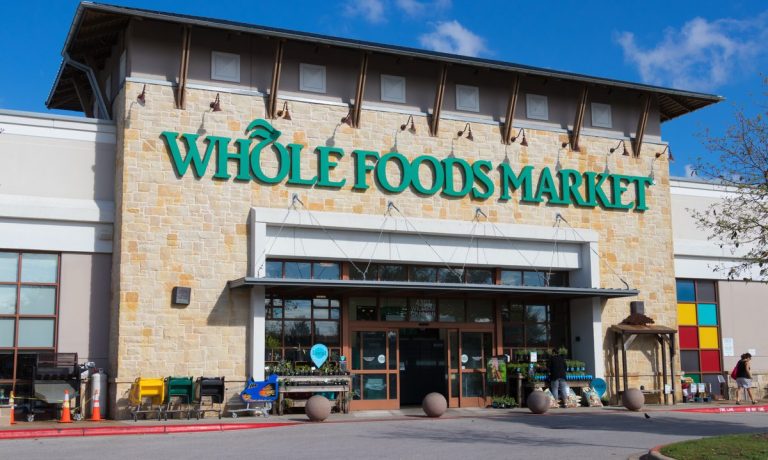Grocery Roundup: Whole Foods Hits a Snag; In-Supermarket Video Marketing Expands

Amazon’s efforts to redirect its brick-and-mortar focus toward grocery may not be going as planned. The Wall Street Journal (WSJ) reported Tuesday (May 3) that the company is closing six Whole Foods Market stores, with five of those locations closing Friday (May 6).
Read more: Amazon to Shutter Physical Bookstores, Focus on Grocery Opportunities
The company did not offer a reason for the closures, although the outlet noted that a spokesperson stated the grocer keeps watch on the “growth potential” of each of its locations.
While Amazon is a leader in many retail categories, it lags top players in grocery. Research from PYMNTS’ April report “Amazon Versus Walmart Q4 2021: The Ongoing Battle for Consumer Retail Spend,” which drew from Amazon and Walmart’s’ quarterly earnings reports and from consumer spending data, found that the average U.S. household still spends roughly 10 times as much on food and beverages at Walmart than at Amazon. In 2021, Walmart captured $264 billion in food and beverage sales, while Amazon captured just $27 billion.
See more: US Consumers Spend 10x More on Groceries at Walmart Than Amazon
H-E-B Adds in-Store Video Marketing
As grocers look to apply the learnings of the digital shift to their omnichannel strategy, many are bringing more tech-forward content into their stores.
Marketing technology company Looma announced Wednesday that it has brought its interactive video advertising screens called Loop into around 120 H-E-B grocery stores in Texas. This move brings the technology to more than a third of the grocer’s locations in the state.
“Working with H-E-B has been an immense privilege,” said Looma Founder and CEO Cole Johnson in a statement. “The care and attention to detail with which they evaluated our partnership from day one has affirmed Loop’s effectiveness and product-market fit; while lending us industry-leading counsel as we’ve sought to refine and evolve our offering.”
The announcement comes days after retail technology company Clerk, which offers “Grocery TV” product enabling video advertising for brands on small in-store screens, announced Friday (April 29) that it had raised $30 million in its Series B funding round, which it will use to expand and to develop its technology.
Read more: Retail Tech Company Clerk Announces $30M Series B as Grocers eCommerce-ify Stores
Initiatives such as this target grocery’s in-store shoppers, a group that accounts for most grocery customers, according to the Decoding Consumer Affinity study, which found that 82% of grocery shoppers prefer purchasing products in stores, while the other 18% prefers to shop digitally.
Schnucks Adds Rewards-Earning Capabilities to Delivery and Curbside Channels
One of the key factors that separates grocers with a successful omnichannel strategy from the rest is the ability to integrate the experience across channels. For instance, if a consumer can earn rewards points on in-store purchases, they will also expect to be able to earn these rewards on digital orders.
Schnucks, a St. Louis, Missouri-based grocer with 112 stores across four Midwestern states, announced Wednesday (May 4) that, where once consumers ordering from its loyalty app were redirected to an external channel for curbside pickup and delivery orders, now they can order through the app and earn rewards.
“By adding additional eCommerce options in the Schnucks Rewards app, we are creating a more streamlined customer experience,” said Schnucks Senior Director of Digital Experience Chace MacMullan in a statement. “We continue to develop and implement app features that allow customers to interact with Schnucks digitally in our stores and at home.”
Rewards are a significant motivator for many grocery shoppers, according to data from PYMNTS’ January study, “Decoding Customer Affinity: The Customer Loyalty to Merchants Survey 2022.” The report, created in collaboration with Toshiba Global Commerce Solutions, which drew from a survey of more than 2,000 U.S. consumers, found that 42% of shoppers said loyalty programs with rewards they like would improve their loyalty to grocery merchants.
See more: Thirty-Five Percent of Consumers Will Switch Grocers, Pharmacies for Better Digital Features
Additionally, research from PYMNTS’ August study, “What Consumers Expect From Their Grocery Shopping Experience,” created in collaboration with ACI Worldwide, which surveyed more than 2,300 U.S. adults in the late spring, found that 23% of grocery shoppers buy online and have the products delivered to their home and 20% buy online and use curbside pickup.
Read more: Digital Features Can Help Grocers Win Over 43% of Shoppers
Kroger Brings Back Its Supplier Accelerator for the Second Year
Kroger, the largest U.S. pure-play grocer, announced Wednesday that it is accepting applications for the second year of Go Fresh & Local Supplier Accelerator program to mentor local and regional growers and producers.
“Kroger is fully committed to supporting a diverse group of innovative, local suppliers who can bring a great assortment of fresh products to our customers,” said Kroger Chief Merchant and Marketing Officer Stuart Aitken in a statement. “Kroger committed to investing $10 billion in diverse suppliers by 2030, and the Go Fresh & Local Supplier Accelerator is a successful way to catapult Kroger closer to that goal. We are excited to meet this year’s suppliers who will help us advance our commitment to fresh in our nearly 2,800 stores.”
The news comes about two months after Whole Foods announced the launch of its Local and Emerging Accelerator Program to mentor emerging producers.
See more: Whole Foods Launches Accelerator